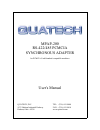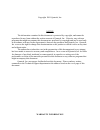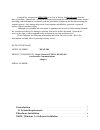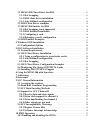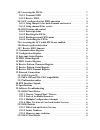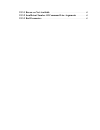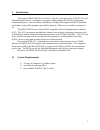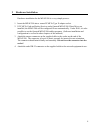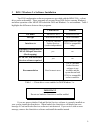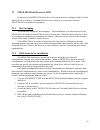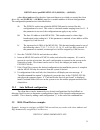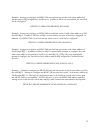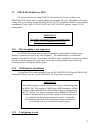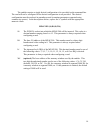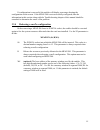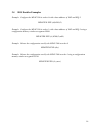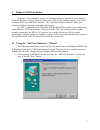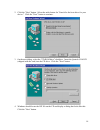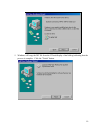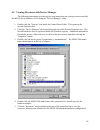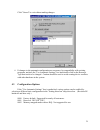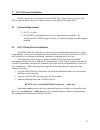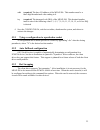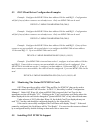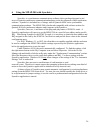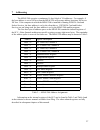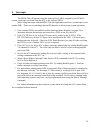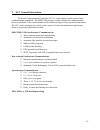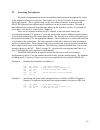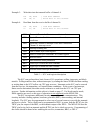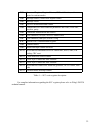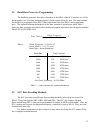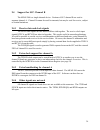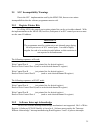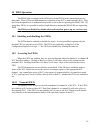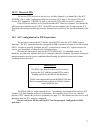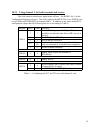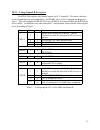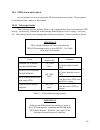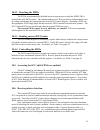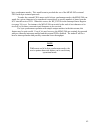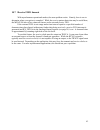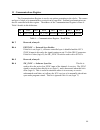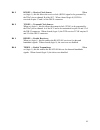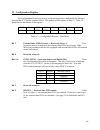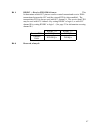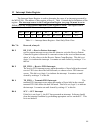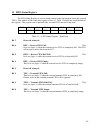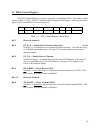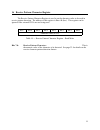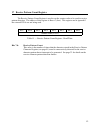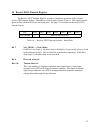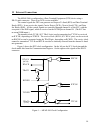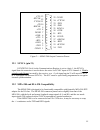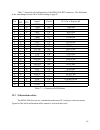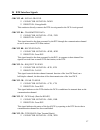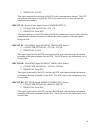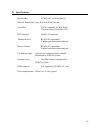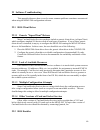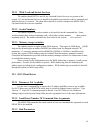- DL manuals
- Quatech
- Software
- MPAP-200
- User Manual
Quatech MPAP-200 User Manual
Summary of MPAP-200
Page 1
Mpap-200 rs-422/485 pcmcia synchronous adapter for pcmcia card standard compatible machines user's manual quatech, inc. Tel: (330) 655-9000 5675 hudson industrial parkway fax: (330) 655-9010 hudson, ohio 44236 www.Quatech.Com.
Page 2
Copyright 2001 quatech, inc. Notice the information contained in this document is protected by copyright, and cannot be reproduced in any form without the written consent of quatech, inc. Likewise, any software programs that might accompany this document are protected by copyright and can be used on...
Page 3
Quatech inc. Warrants the mpap-200 to be free of defects for five (5) years from the date of purchase. Quatech inc. Will repair or replace any board that fails to perform under normal operating conditions and in accordance with the procedures outlined in this document during the warranty period. Any...
Page 4
37 10.1 enabling and disabling the fifos . . . . . . . . . . . . . . . . . . . . . . . . . . . . . 37 10 fifo operation . . . . . . . . . . . . . . . . . . . . . . . . . . . . . . . . . . . . . . . . . . . . . . . . . 36 9.5.2 software interrupt acknowledge . . . . . . . . . . . . . . . . . . . . . ...
Page 5
62 22.3 os/2 client driver . . . . . . . . . . . . . . . . . . . . . . . . . . . . . . . . . . . . . . . . . . . 62 22.2.3 memory range exclusion . . . . . . . . . . . . . . . . . . . . . . . . . . . . . . . . . . 62 22.2.2 socket numbers . . . . . . . . . . . . . . . . . . . . . . . . . . . . . . ....
Page 6
63 22.3.3 bad parameters . . . . . . . . . . . . . . . . . . . . . . . . . . . . . . . . . . . . . . . . . . . 62 22.3.2 insufficient number of command line arguments . . . . . . . . 62 22.3.1 resources not available . . . . . . . . . . . . . . . . . . . . . . . . . . . . . . . . . ..
Page 7
1 introduction the quatech mpap-200/300 is a pcmcia type ii (5 mm) card and is pcmcia pc card standard specification 2.1 compliant. It provides a single-channel rs-422/485 synchronous communication port. The base address and irq are configured through the pcmcia hardware and software using utility p...
Page 8
2 hardware installation hardware installation for the mpap-200 is a very simple process: 1. Insert the mpap-200 into a vacant pcmcia type ii adapter socket. 2. If pcmcia card and socket services and a quatech mpap-200 client driver are installed, the mpap-200 will be configured for use automatically...
Page 9
3 dos / windows 3.X software installation two dos configuration software programs are provided with the mpap-200: a client driver and a card enabler. These programs are executed from dos (before entering windows) and allow operation of the mpap-200 in both the dos and windows 3.X environments. Table...
Page 10
3.1 mpap-200 client driver for dos in order to use the mpap-200 client driver, the system must be configured with card and socket services software. Card and socket services software is not provided with the mpap-200 but is available from quatech. 3.1.1 hot swapping the client driver supports "hot s...
Page 11
Device=drive:\path\mpap2cl.Sys (s#,b#,i#) ... (s#,b#,i#) where drive:\path specifies the drive letter and directory to which you copied the client driver file, and (s#,b#,i#) ... (s#,b#,i#) stand for a variable number of desired configurations. The configuration parameters are described below. S# th...
Page 12
Example: attempt to configure an mpap-200 inserted into any socket with a base address of 300 hex and an irq assigned by card services. If address 300 hex is unavailable, the card will not be configured. Device=c:\mpap-200\mpap2cl.Sys (b300) example: attempt to configure an mpap-200 inserted into so...
Page 13
3.3 mpap-200 enabler for dos for systems that are not using pcmcia card and socket services software, the mpap-200 dos enabler may be used to enable and configure the card. The enabler will operate on any dos system using an intel 82365sl (pcic) or pcic-compatible pcmcia socket adapter including the...
Page 14
The enabler requires a single desired configuration to be provided on the command line. The card will not be configured if the desired configuration is not provided. The desired configuration must be enclosed in parentheses and it contains parameters separated using commas (no spaces). In the descri...
Page 15
If configuration is successful, the enabler will display a message showing the configuration on the screen. If the mpap-200 is not successfully configured, then the information in this section along with the troubleshooting chapter of this manual should be consulted to determine the cause of the pro...
Page 16
3.4 dos enabler examples example: configure the mpap-200 in socket 0 with a base address of 300h and irq 5. Mpap2en.Exe (s0,b300,i5) example: configure the mpap-200 in socket 1 with a base address of 300h and irq 3 using a configuration memory window at segment d800. Mpap2en.Exe (s1,b300,i3,wd8) exa...
Page 17
4 windows 95/98 installation windows 95/98 maintains a registry of all known hardware installed in your computer. Inside this hardware registry windows keeps track of all of your system resources, such as i/o locations, irq levels, and dma channels. The "add new hardware wizard" utility was designed...
Page 18
2. Click the "next" button. Select the radio button for "search for the best driver for your device." click the "next" button to continue. 3. On the next dialog, select the "cd-rom drive" checkbox. Insert the quatech com cd (shipped with the card) into the cd drive. Click the "next" button. 4. Windo...
Page 19
5. Windows will copy the inf file from the cd and display a final dialog indicating that the process is complete. Click the "finish" button. 19.
Page 20
4.2 viewing resources with device manager the following instructions provide step-by-step instructions on viewing resources used by the mpap-200 in windows 95/98 using the "device manager" utility. 1. Double click the "system" icon inside the control panel folder. This opens up the system properties...
Page 21
Click "cancel" to exit without making changes. 6. If changes to the automatic configuration are necessary for compatibility with existing programs, uncheck the "use automatic settings" box and double-click on the resource type that needs to be changed. Caution should be used to avoid creating device...
Page 22
5 os/2 software installation an os/2 client driver is provided with the mpap-200. This client driver works with os/2's card and socket services to allow operation of the mpap-200 under os/2. 5.1 system requirements os/2 2.1 or later. Os/2 pcmcia card and socket services support must be installed. Se...
Page 23
Addr (required) the base i/o address of the mpap-200. This number must be a three-digit hexadecimal value ending in 0. Irq (required) the interrupt level (irq) of the mpap-200. This decimal number must be one of the following values: 3, 4, 5, 7, 9, 10, 11, 12, 14, 15, or 0 if no irq is desired. 4. S...
Page 24
5.3 os/2 client driver configuration examples example: configure the mpap-200 at base address 300 hex and irq 5. Configuration will fail if any of these resources are already in use. Only one mpap-200 can be used. Device=c:\mpap-200\mpap200.Sys (300,5) example: configure the mpap-200 at base address...
Page 25
If pcmcia support was not selected when os/2 was installed, add it by using the selective install facility in the system setup folder. Full pcmcia support is built into os/2 warp 3.0 and later. On os/2 2.1 and 2.11, pcmcia card services is built in, but you must add socket services separately. The n...
Page 26
6 using the mpap-200 with syncdrive syncdrive is a synchronous communications software driver package designed to aid users of quatech synchronous communication hardware in the development of their application software. Syncdrive is included free of charge with all quatech mpa-series synchronous com...
Page 27
7 addressing the mpap-200 occupies a continuous 16-byte block of i/o addresses. For example, if the base address is set to 300 hex, then the mpap-200 will occupy address locations 300 hex to 30f hex. If the computer in which the mpap-200 is installed is running pcmcia card and socket services, the b...
Page 28
8 interrupts the mpap-200 will operate using the interrupt level (irq) assigned by the pcmcia system. Interrupts can come from the scc or the external fifos. When using interrupts with the mpap-200, the application must have an interrupt service routine (isr). There are several things that an isr mu...
Page 29
9 scc general information the serial communications controller (scc) is a dual channel, multi-protocol data communications peripheral. The mpap-200 provides a single channel for communications, however, portions of the second channel can be utilized to support some special circumstances. The scc can...
Page 30
9.1 accessing the registers the mode of communication desired is established and monitored through the bit values of the internal read and write registers. The register set of the scc includes 16 write registers and 9 read registers. These registers only occupy four address locations, which start at...
Page 31
Example 3: write data into the transmit buffer of channel a. Mov dx, base ; load base address out dx, al ; write data in ax to buffer example 4: read data from the receive buffer of channel a. Mov dx, base ; load base address in al, dx ; write data in ax to buffer external/status interrupt informati...
Page 32
External/status interrupt control wr15 miscellaneous control bits: baud rate generator, dpll control, auto echo wr14 lower byte of baud rate time constant wr13 lower byte of baud rate time constant wr12 clock mode and source control wr11 miscellaneous transmitter/receiver control bits, nrzi, nrz, fm...
Page 33
9.2 baud rate generator programming the baud rate generator (hereafter referred to as the brg) of the scc consists of a 16-bit down counter, two 8-bit time constant registers, and an output divide-by-two. The time constant for the brg is programmed into wr12 (least significant byte) and wr13 (most s...
Page 34
9.4 support for scc channel b the mpap-200 is a single-channel device. Portions of scc channel b are used to augment channel a. Channel b cannot be used for transmit, but may be used for receive, subject to certain limitations. 9.4.1 receive data and clock signals the receive data signals rxda and r...
Page 35
9.5 scc incompatibility warnings due to the scc implementation used by the mpap-200, there are two minor incompatibilities that the software programmer must avoid. 9.5.1 register pointer bits in a zilog 85230, the control port register pointer bits can be set in either channel. With the implementati...
Page 36
10 fifo operation the mpap-200 is equipped with 1024-byte external fifos in the transmit and receive data paths. These fifos are implemented as extensions of the scc's small internal fifos. They have been designed to be as transparent as possible to the software operating the mpap-200. By using thes...
Page 37
10.2.2 receive fifo the receive fifo can service the receiver of either channel a or channel b of the scc. If rxsrc (bit 1) of the configuration register (see page 36) is logic 1, the receive fifo will service scc channel b. If rxsrc is logic 0, the receive fifo will service scc channel a. If the fi...
Page 38
10.3.1 using channel a for both transmit and receive this is the mode in which most applications will run. Set rxsrc (bit 1) in the configuration register to logic 0. This will configure the mpap-200 to use w/reqa for receive dma and dtr/reqa for transmit dma. In addition to any other desired scc co...
Page 39
10.3.2 using channel b for receive the mpap-200 supplies only limited support for scc channel b. This mode, therefore, is not recommended for most applications. Set rxsrc (bit 1) in the configuration register to logic 1. This will configure the mpap-200 to use w/reqa for transmit dma and w/reqb for ...
Page 40
10.4 fifo status and control several registers are used to control the fifos and monitor their status. These registers are detailed in other chapters of this manual. 10.4.1 interrupt status three interrupt statuses, listed in table 8, can be generated by four events related to fifo activity. In each...
Page 41
10.4.2 resetting the fifos the fifos are automatically disabled and reset at powerup or when the mpap-200 is inserted into a pcmcia socket. The transmit and receive fifos can also be independently reset by setting and clearing the appropriate bits in the fifo control register. Resetting a fifo sets ...
Page 42
Byte-synchronous modes. This would seem to preclude the use of the mpap-200's external fifos with byte-oriented protocols. To make the external fifos more useful in byte-synchronous modes, the mpap-200 can watch for a given character to be transferred consecutively a specific number of times from th...
Page 43
10.7 receive fifo timeout with asynchronous operational modes, the same problem exists. Namely, how is one to determine when a reception is complete? While the receive pattern detection may be useful here, the mpap-200 also offers a timeout feature on the external receive fifo. If the external fifo ...
Page 44
11 communications register the communications register is used to set options pertaining to the clocks. The source and type of clock to be transmitted or received can be specified. External synchronization can also be controlled with this register. The address of the communications register is base+...
Page 45
Bit 3: rcken --- receive clock source: when set (logic 1), this bit allows the receive clock (rclk) signal to be generated by the trxc pin on channel b of the scc. When cleared (logic 0), rclk is received on pins 17 and 9 of the db-25 connector. Bit 2: tcken --- transmit clock source: when set (logi...
Page 46
12 configuration register the configuration register is used to set the interrupt source and enable the interface between the scc and the external fifos. The address of this register is base+5. Table 10 details the bit definitions of the register. 0 rxsrc fifoen 0 ints0 ints1 0 1 bit 0 bit 1 bit 2 b...
Page 47
Bit 1: rxsrc --- receive fifo dma source: this bit determines which scc pins are used to control transmit and receive dma transactions between the scc and the external fifos (when enabled). The transmit data fifo is always used with scc channel a. The receive data fifo may be used with scc channel a...
Page 48
13 interrupt status register the interrupt status register is used to determine the cause of an interrupt generated by the mpap-200. The address of this register is base+8. Table 11 details the bit definitions of the register. The interrupt source in the configuration register (see page 36) must be ...
Page 49
14 fifo status register the fifo status register is used to return current status information about the external fifos. The address of this read-only register is base+9. Table 12 details the bit definitions of the register. This register can be ignored if the external fifos are not being used. Txe t...
Page 50
15 fifo control register the fifo control register is used to control the external data fifos. The address of this register is base+a (hex). Table 13 details the bit definitions of the register. This register can be ignored if the external fifos are not being used. Tx_reset 0 0 0 rx_reset en_to en_p...
Page 51
16 receive pattern character register the receive pattern character register is used to set the character value to be used in receive pattern detection. The address of this register is base+b (hex). This register can be ignored if the external fifos are not being used. Character value (0-255) bit 0 ...
Page 52
17 receive pattern count register the receive pattern count register is used to set the counter value to be used in receive pattern detection. The address of this register is base+c (hex). This register can be ignored if the external fifos are not being used. Counter value (0-255) bit 0 bit 1 bit 2 ...
Page 53
18 receive fifo timeout register the receive fifo timeout register is used to control the operation of the external receive fifo timeout feature. The address of this register is base+d (hex). This register can be ignored if the external fifos are not being used. See page 33 for details on the receiv...
Page 54
19 external connections the mpap-200 is configured as a data terminal equipment (dte) device using a db-25 male connector. There is no dce version available. The control signals the dte can generate are request to send (rts) and data terminal ready (dtr). It can receive the signals carrier detect (d...
Page 55
-cts -rtclk -ttclk -cd -rrclk +cd dgnd +dsr +cts +rts +rxd +txd cgnd 13 12 11 10 9 8 7 6 5 4 3 2 1 25 24 23 22 21 20 19 18 17 16 15 14 cgnd +ttclk -rts -rxd synca +dtr -txd cgnd +rrclk -dtr +rtclk -dsr figure 2 --- mpap-200 output connector pinout 19.1 synca (pin 21) if extsync (bit 6) in the commun...
Page 56
Table 17 shows the pin configuration of the mpap-200 dte connector. The definitions of the interchange circuits can be found starting on page 47. Cgnd 25 trxca pin da +ttclk x 24 dtr/reqa pin cd -dtr x 23 dcdb pin cc -dsr x 22 synca pin synca x 21 dtr/reqa pin cd +dtr x 20 rtsa pin ca -rts x 19 cgnd...
Page 57
20 dte interface signals circuit ab - signal ground connector notation: dgnd direction: not applicable this conductor directly connects the dte circuit ground to the dce circuit ground. Circuit ba - transmitted data connector notation: +txd, -txd direction: to dce this signal transfers the data gene...
Page 58
Direction: to dce this signal controls the switching of the dce to the communication channel. The dte will generate this signal to prepare the dce to be connected to or removed from the communication channel. Circuit cf - received line signal detect (carrier detect) connector notation: +cd, -cd dire...
Page 59
21 specifications bus interface: pcmcia pc card standard 2.1 physical dimensions: type ii (5 mm) pcmcia card controller: 85230-compatible 16-mhz serial communications controller (scc) dte interface: male d-25 connector transmit drivers: rs-422/485 compatible, 5 mbps typical maximum data rate receive...
Page 60
22 software troubleshooting this appendix discusses how to resolve some common problems sometimes encountered when using the mpap-200 configuration software. 22.1 dos client driver 22.1.1 generic "superclient" drivers many card and socket services packages include a generic client driver (or supercl...
Page 61
22.2.1 with card and socket services the enabler should not be used if any card and socket services are present on the system. If card and socket services is installed, the enabler may interfere with its operation and with the device(s) it controls. The client driver should be used to configure the ...
Page 62
The base address or irq value may be out of range. Make sure that the base address is a hexadecimal number between 100 hex and 3f0 hex ending in 0. Make sure that the irq is a decimal number between 2 and 15. 62.
Page 63
56.
Page 64
Mpap-200 user's manual revision 2.32 march 2004 p/n 940-0129-232 57.

